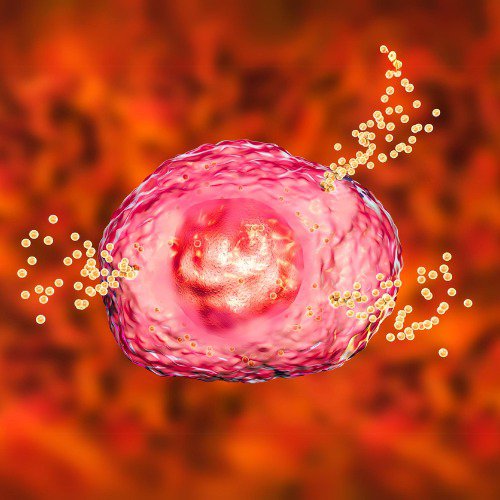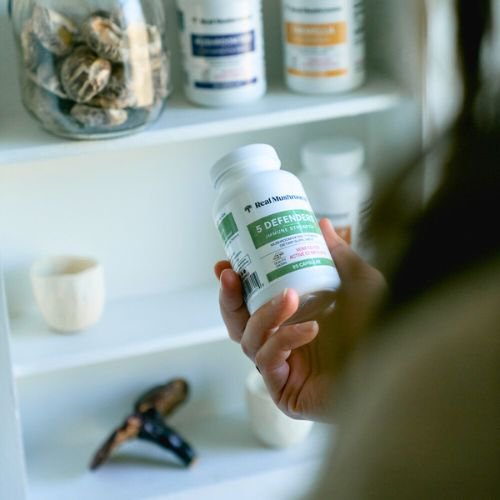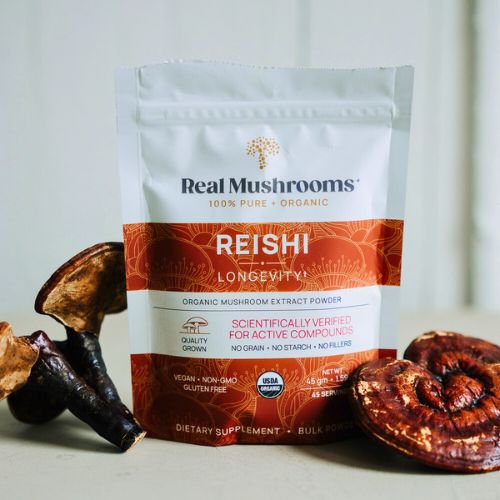Menu


Note: This article is part of our One Health series of articles that looks at how both pet and human bodies function and respond to multifunctional mushrooms.
Seasonal allergy sufferers know the drill: certain times of the year bring about a series of unwanted symptoms that can make life miserable. These people experience red and itchy eyes, with tearing, sneezing, and a copious, clear runny nasal discharge. These are the major symptoms we see in humans, the 2-legged animal. Our 4-legged animals—dogs and cats—also experience seasonal allergies, but they have different symptoms (more on that later).
Luckily, functional mushrooms are a natural solution that safely and effectively balances the immune system. For both pets and humans, mushroom extracts can be a welcome addition to the protocol for alleviating symptoms of occasional allergies.
Most of the symptoms we see in people, dogs, and cats are due to the activation of a specific type of immune cell, the mast cell. These white blood cells contain little sacs (vesicles) that are packed with histamine, a compound that plays a pivotal role in allergic responses.
When an allergic reaction is triggered, these cells release their histamine into the surrounding tissue, leading to small blood vessels and capillaries becoming “leaky.” This leakiness contributes to the swelling we can see with allergies. Think hives. Histamine also stimulates the itchiness (pruritis) that is a part of seasonal allergies (1).

In the human animal, the distribution of mast cells is primarily in the respiratory system: The lungs, upper respiratory airways, nose, sinuses, and eyes. Therefore, when a person has seasonal allergies, their symptoms are primarily upper respiratory in nature (2).
On the other hand, when a dog or a cat experiences seasonal allergies—what veterinarians call “environmental” or “inhalant” allergies—they have very few upper respiratory symptoms.
In contrast to humans, the mast cells in animals are found predominantly in the skin, versus the lungs. The resulting symptoms for pets are intense itchiness and scratching which can cause self-mutilation, ulcerations, hair loss, and sores. Furthermore, the inflammation can alter the skin’s microbiome and oils. In dogs and cats, we call the skin reactions from seasonal, inhalant allergies, “atopic dermatitis” (3).
When humans have involvement of their skin in symptoms of allergies, it is called “eczema.” People with eczema tend to have a higher distribution of mast cells in their skin than the general human population. There are multiple forms of eczema in humans, and one form is called, “atopic dermatitis”, which is very similar to the same condition in our pets (4).

Seasonal allergies can be due to the inhalation of small particulate matter from plants and animals that contain antigens like pollen, dander, or dust. If a person inhales these antigens, they could cause upper respiratory symptoms. In a dog or cat, these antigens would cause itching and redness of the skin, typical symptoms of a histamine reaction.
“Contact allergies” are those due to contact with materials that cause a reaction on the surface of the skin. “Food allergies” are a type of allergy that results from ingested material. Food allergies as well as contact allergies are not dependent on the climate or time of year. The information in this article is relevant only to seasonal or occasional allergies. Contact or food allergies are chronic and more complex conditions that typically require pharmaceutical interventions.
Managing allergies, whether you have 2 legs or 4, can be quite complicated. There isn’t always a simple solution or short answer to managing them and helping to reduce allergy symptoms. It is known, though, that certain mushroom species can better help manage the occasional symptoms of seasonal allergies.
Since allergies are so complex and have many different causes, it would be uncommon for a pet or a person with allergies to find that mushrooms alone could support their healthy response. This is why it’s important to have a multi-modal response to allergic symptoms by addressing leaky gut with diet changes and supplements, and possibly combining the mushrooms with herbs, or pharmaceuticals, like antihistamines or antibiotics.

Two mushrooms in particular have good evidence they can stabilize the membranes of mast cells, thus resulting in an antihistamine-like response by the person or critter. One of these mushrooms is called “Reishi”, and has also been called the Mushroom of Immortality due to its overall beneficial properties. The other mushroom is called “Chaga”. Although these mushrooms have many other beneficial constituents and properties, their “secret sauce” for the symptoms of allergies are the unique molecules they contain called “triterpenes”. These fairly large molecules interfere with the mast cell’s ability to release its histamine granules and that helps to reduce these histamine-related symptoms (5,6).
These two mushrooms, Reishi and Chaga, can be taken together as individual mushroom products, or you may want to try a proprietary Real Mushroomä product that contains 5 very potent mushrooms including Reishi and Chaga: The 5 Defenders. When we blend different species of mushrooms into a single formula, the combination of mushrooms is stronger than any individual mushroom due to the synergy that multiple mushrooms can create.

The conventional approach to managing the symptoms of allergies is to use products that contain pharmaceuticals that prevent the release of histamine from mast cells. These antihistamines can be effective in providing symptomatic relief but do nothing to modify the course of the allergy, in terms of “cure” or reduced intensity of the allergic symptoms. Side effects generally are minimal with antihistamines, and they usually do not interfere with other drugs, but in some cases, they may not be effective or may cause excessive drowsiness or a change of behavior.
A third beneficial property that mushrooms have regarding allergies, is their ability to improve immune system function by means of their beta-glucan compounds. The beta-glucans are polysaccharide molecules that enhance immune system function by activating immune cells to produce anti-inflammatory compounds, and, if the immune system is “overactive”, as with allergies, beta-glucans can also help to balance the immune system and reduce its reactivity to innocuous antigens, as is the case with the allergic response (7).
Finally, there is a fourth property that mushrooms have which can also be beneficial with allergies, whether they be inhalant and seasonal in nature, or from ingested food materials. Mushrooms contain a high percentage of indigestible fiber, in the form of the beta-glucans discussed in the prior paragraph, and another type of fiber that is a precursor for a type of glucosamine that helps to heal a leaky gut known as Chitin (8).
These mushroom fibers provide excellent fuel for the good bugs of the GI microbiome, which in turn, improves immune and gut health. By improving the health of the microbiome we can reduce the development of allergic symptoms by stabilizing the bowel wall so it doesn’t leak pro-inflammatory antigens into the body’s systemic circulation. This decreases inflammation in the body as a whole and can help reduce allergic symptoms. Several studies support the value of using probiotics to support a healthy microbiome and reducing leaky gut to reduce allergy symptoms in people. (No studies yet in our veterinary species) (9,10).
The best way to give mushrooms to your pet is as a powder, or in capsules that can be given with food to make it easy for you and your pet. Real Mushrooms makes highly concentrated standardized extracts of these two mushrooms that have antihistaminic properties. You can get these mushroom extracts in capsules, in bulk powder, or in soft chews for your pet. The Reishi mushroom is very bitter and may need to be given in capsules to improve acceptance.

If you are a human, then taking 1-4 capsules daily, or ½-1 teaspoon of powdered mushroom extract would be a good place to start your healthy journey, and might be the right amount for you to take. Wait at least 2 weeks, and if you are not getting the healthy response you would like, it would be very safe to double the amount you have been taking.
If you are providing the mushroom for your pet, my recommendation is to dose the powder at 1/8 tsp for every 10 pounds of body weight twice daily as a good place to start. You might find after several weeks that a larger amount administered may provide better results.

Mushrooms are extremely safe, they are basically a superfood, so no worries about giving a much larger amount, unless your pet has palatability issues with the amount of mushroom product being administered. It may take 2 (or more) weeks for the mushrooms to have their best effect.
To conclude, seasonal allergies can substantially impact the quality of life. By following a program to support the microbiome, reduce leaky gut, and tame the symptoms of histamine release with mushrooms, probiotics, diet, and herbs, can help bring relief to sufferers of allergy symptoms, whether 2-legged or 4-legged.

Disclaimer: The information or products mentioned in this article are provided as information resources only, and are not to be used or relied on to diagnose, treat, cure, or prevent any disease. This information does not create any patient-doctor relationship, and should not be used as a substitute for professional diagnosis and treatment. The information is intended for health care professionals only. The statements made in this article have not been evaluated by the Food and Drug Administration. Any products mentioned are not intended to diagnose, treat, cure, or prevent any disease. The information in this article is intended for educational purposes. The information is not intended to replace medical advice offered by licensed medical physicians. Please consult your doctor or health practitioner for any medical advice.